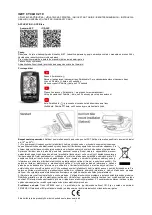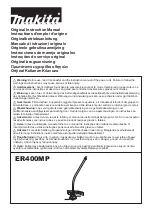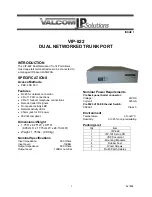
8/16
5.5 Maintenance
Attention: Do not disassemble or try to repair the device. In case of any malfunction or
failure, replace the entire device.
Attention: Correct operation cannot be guaranteed when the device is deformed or
damaged.
The installer is responsible for establishing the sequence of functional tests to which the installed
device is to be subject for a complete maintenance. The testing sequence can vary according to the
machine complexity and circuit diagram, therefore the functional test sequence detailed below is to
be considered as minimal and not exhaustive.
At least once a year or after prolonged stoppage, carry out the following checking operations:
1) All external parts must be undamaged.
2) If the device is damaged, replace it completely.
3) The actuator must be securely locked to the door; make sure that
none of the machine operator’s tools can be used to disconnect the actuator
from the door.
4) When the machine is in operation, the door opening must result in an immediate stop
of the machine itself.
5) It must not be possible to restart the machine with the door open.
6) The device has been created for applications in dangerous environments, therefore
its operation is time-limited. Although still functioning, after 20 years from the date of manufacture
the device
must be replaced completely. The date
of manufacture is placed next to the product code (see paragraph 5.10).
5.6 Caution when wiring
• Check that the supply voltage is correct before powering the device.
• Keep the charge within the values specified in the electrical operation categories.
• Disconnect the power supply before accessing the device connections.
• Only connect and disconnect the device when the power is off.
• Discharge static electricity before handling the product by touching a metal mass connected to
earth. Any strong ESD discharge could damage the device.
• Always connect the protection fuse (or equivalent device) in series with the power supply for each
device (see paragraph 6.3).
5.7 Additional prescriptions for safety applications with operator protection functions
Provided that all previous requirements for the devices installed with operator protection function are
fulfilled, further additional prescriptions have to be observed:
• In any event, utilization implies compliance with and awareness of standards EN 60947-5-3, EN
ISO 14119, IEC 60204-1, EN ISO 13849, EN 62061, ISO 12100.
• Periodically verify the correct working of the safety devices; the periodicity of this verification is
settled by the machine manufacturer based on the machine danger degree and it does not have
to be less than one a year.
5.8 Utilization limits
•
The sensor can be used as a safety device (EN 60204) associated to a movable guard, acc. to
standard EN 60947-5-3.
•
The device can be used as a component within a system having safety category 4 PLe according to
EN ISO 13849-1 and integrity level SIL CL 3 according to EN 62061.
• Use the device following the instructions, complying with its operation limits and the standards in
force.
• The devices have specific application limits (min. and max. ambient temperature, mechanical
endurance, protection degree, etc.) These limitations are met by the device only if considered
individually and not as combined with each other.
• The manufacturer’s liability is to be excluded in the following cases:
• Use not conforming to the intended purpose.
• Failure to observe safety instructions.
• Fitting operations not carried out by qualified and authorized personnel.
• Omission of functional tests.
For the cases listed below, contact our assistance service (see paragraph 9):
• • In nuclear power stations, trains, airplanes, cars, incinerators, medical devices or any application
where the safety of two or more persons depend on the correct operation of the device.
• Applications, which are not contemplated in the instruction sheet.
5.9 Functional tests before commissioning the device
The device installer is responsible for establishing the sequence of functional tests to which the
installed device is to be subject before machine commissioning. The testing sequence can vary
according to machine complexity and circuit diagram, therefore the functional test sequence given is
to be considered minimal and non-exhaustive.
The sequence of functional tests to be executed prior to commissioning is the same as the
maintenance sequence (see paragraph 5.5).
5.10 Marking
The outside of the device is provided with external marking positioned in a visible place. Marking
includes:
• Producer trademark
• Product code
• Batch number and date of manufacture. Example: A14 ST1-411. The batch's first letter refers to
the month of manufacture (A=January, B=February, etc.). The second and third letters refer to the
year of manufacture (14 =2014, 15=2015, etc…).
6 TECHNICAL DATA
6.1 Housing
Housing made of glass fibre reinforced technopolymer, self-extinguishing.
Versions with integrated cable 6 x 0.5 mm
2
or 8 x 0.34 mm
2
, length 2 m, other lengths on request.
Versions with M12 connector
Versions with 0.1 m cable length and M12 connector
Maximum length of connecting cables:
50 m
(The cable length and section alter the deactivation impulses at the safety outputs. Check that the capacity between the
connecting cable's conductors is lower than that permitted in the electrical data of the safety outputs)
Protection degree:
IP67 acc. to EN 60529
IP69K acc. to ISO 20653
(Protect the cables from direct high-pressure and high-temperature jets)
6.2 General data
For safety applications up to:
SIL 3 acc. to EN 62061
PL e, cat. 4 acc. to EN ISO 13849-1
Interlock without contact, coded:
type 4 acc. to EN ISO 14119
Coding level acc. to EN ISO 14119:
high with
•
1T actuator
low with
•
0T actuator
Safety parameters:
MTTF
d
:
4077 years
PFH
d
: 1.46E-09
DC: High
Service life:
20 years
Operating temperature:
-25 … +70°C
Storage and transport temperature:
-25 … +85°C
Vibration resistance:
10 gn (10...150 Hz)
acc. to IEC 60068-2-6
Shock resistance:
30 gn; 11 ms
acc. to EN 60068-2-27
Pollution degree
3
Screw tightening torque:
0.8 … 2 Nm
6.3 Power supply electrical data
Rated operating voltage U
e
(ST D•••0•• versions):
24 Vdc -15% … +10% SELV
Rated operating voltage U
e
(ST D•••1•• versions):
12 ... 24 Vdc -30%...+25% SELV
Operating current at U
e
voltage:
- minimum:
40 mA
- with all outputs at maximum power:
0.7 A
Rated insulation voltage U
i
:
32 Vdc
Rated impulse withstand voltage U
imp
:
1.5 kV
External
protection
fuse:
1 A type F
or equivalent device
Overvoltage category:
III
6.4 Electrical data of IS1/IS2/I3/EDM inputs
Rated operating voltage U
e1
(ST D•••0•• versions):
24 Vdc
Rated operating voltage U
e1
(ST D•••1•• versions):
12 ... 24 Vdc
Rated current consumption:
5 mA
Switching time EDM state (t
EDM
):
500 ms
6.5 Electrical data of OS1/OS2 safety outputs
Rated operating voltage U
e2
(ST D•••0•• versions):
24 Vdc
Rated operating voltage U
e2
(ST D•••1•• versions):
12 ... 24 Vdc
Output type:
PNP type OSSD
Maximum current per output I
e2
:
0.25 A
Minimum current per output I
m2
:
0.5 mA
Thermal current I
th2
:
0.25 A
Utilization category:
DC13; U
e2
=24 Vdc, I
e2
=0.25 A
Short circuit detection:
Yes
Overcurrent protection:
Yes
Resettable internal protection fuse:
0.75 A
Duration of the deactivation impulses at the safety outputs:
< 300 us
Permissible capacitance between outputs:
< 200 nF
Permissible capacitance between output and ground:
< 200 nF
6.6 Electrical data of O3 signalling output
Rated operating voltage U
e3
(ST D•••0•• versions):
24 Vdc
Rated operating voltage U
e3
(ST D•••1•• versions):
12 ... 24 Vdc
Output type:
PNP
Maximum current per output I
e3
:
0.1 A
Utilization category:
DC12; U
e3
=24 Vdc, I
e3
=0.1 A
Short circuit detection:
No
Overcurrent protection:
Yes
Resettable internal protection fuse:
0.75 A
6.7 Actuation characteristics
SM D
•T
SM E •T
Assured operating distance S
ao
:
10 mm
16 mm
Assured release distance S
ar
:
16 mm
27 mm
Rated operating distance S
n
:
12 mm
20 mm
Rated release distance S
nr
:
14 mm
23 mm
Repeat accuracy:
≤
10 %
S
n
Differential travel:
≤
20 %
S
n
Max. switching frequency:
1 Hz
Distance between two sensors:
min. 50 mm
Response time (tr
I
) after deactivation of inputs IS1 or IS2:
- typical:
7 ms
- maximum:
12 ms
Response time (tr
A
) after actuator removal:
- typical:
80 ms
- maximum:
150 ms
6.8 Compliance with standards:
EN ISO 14119, IEC 61508-1, IEC 61508-2, IEC 61508-3, IEC 61508-4, EN ISO 13849-1,
EN ISO 13849-2, EN 62061, EN 60947-5-3 / A1, EN 60947-5-2, EN 60947-1, EN 61326-1,
EN 61326-3-1, EN 61326-3-2, ETSI EN 301 489-1, ETSI EN 301 489-3, ETSI EN 300 330-2,
UL 508, CSA 22.2 No.14
6.9 Compliance with the requirements of:
Machinery Directive 2006/42/EC
EMC Directive 2014/30/EC
Directive 2014/53/EU - RED
FCC Part 15
7 SPECIAL VERSIONS ON REQUEST
Special versions of the device are available on request.
These special versions may differ substantially from the indications in this instruction sheet.
The installer must ensure that he has received written information from the support service regarding
use of the special version requested.
8 DISPOSAL
At the end of service life product must be disposed of properly, according to the rules in force in the
country in which the disposal takes place.
9 SUPPORT
The device has been created for safeguarding people’s physical safety, therefore in case of any
doubt concerning installation or operation methods, always contact our technical support service:
Pizzato Elettrica Srl - Italy
Via Torino, 1 - 36063 Marostica (VI)
Tel39.0424.470.930
Fax +39.0424.470.955
E-mail [email protected]
www.pizzato.com
Our support service provides assistance in Italian and English
10 EC CONFORMITY DECLARATION
I, the undersigned, as a representative of the following manufacturer:
Pizzato Elettrica s.r.l. , Via Torino, 1 - 36063 Marostica (VI) - Italy
hereby declare that the product is in conformity with whatever prescribed by the 2006/42/EC Machine
Directive. The complete version of the present conformity declaration is available on our website
www.pizzato.com
Mr. Pizzato Giuseppe
Disclaimer:
Subject to modifications without prior notice and errors excepted. The data given in this sheet are
accurately checked and refer to typical mass production values. The device descriptions and its
applications, the fields of application, the external control details, as well as information on installation
and operation, are provided to the best of our knowledge. This does not in any way mean that the
characteristics described may entail legal liabilities extending beyond the “General Terms of Sale”,
as stated in the Pizzato Elettrica general catalogue. Customers/users are not absolved from the
obligation to read and understand our information and recommendations and pertinent technical
standards, before using the products for their own purposes. Taking into account the great variety of
applications and possible connections of the device, the examples and diagrams given in the present
manual are to be considered as merely descriptive; the user is deemed responsible for checking that
the specific application of the device complies with current standards. This document is a translation
of the original instructions. In case of discrepancy between the present sheet and the original copy, the
Italian version shall prevail. The present manual may not be reproduced, in whole or in part, without
the prior written permission by Pizzato Elettrica.
All rights reserved.
©
2016
Cop
yr
ight Pizzato Elettr
ica - tr
anslation of the or
iginal instr
uctions


































